Publications
Theses
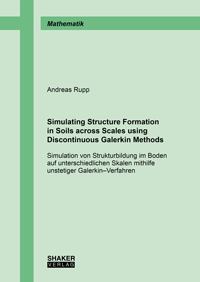
Rupp, Andreas
Simulating Structure Formation in Soils across Scales using Discontinuous Galerkin Methods PhD Thesis
Friedrich-Alexander-Universität Erlangen-Nürnberg (FAU), 2019, ISBN: 978-3-8440-6801-6.
@phdthesis{Rupp19,
title = {Simulating Structure Formation in Soils across Scales using Discontinuous Galerkin Methods},
author = {Andreas Rupp},
editor = {Peter Knabner and Albert J. Valocchi and Alexandre Ern},
url = {https://www.shaker.de/de/content/catalogue/index.asp?lang=de&ID=8&ISBN=978-3-8440-6801-6&search=yes
https://nbn-resolving.org/urn:nbn:de:bvb:29-opus4-112528
https://opus4.kobv.de/opus4-fau/frontdoor/index/index/year/2019/docId/11252},
doi = {10.2370/9783844068016},
isbn = {978-3-8440-6801-6},
year = {2019},
date = {2019-06-28},
urldate = {2019-06-28},
publisher = {Shaker Verlag GmbH & OPUS FAU – Online publication system of FAU Erlangen–Nürnberg},
address = {Düren & Erlangen},
school = {Friedrich-Alexander-Universität Erlangen-Nürnberg (FAU)},
abstract = {This thesis deals with mathematical modeling, analysis, and numerical realization of microaggregates in soils. These microaggregates have the size of a few hundred micrometers and can be understood as the fundamental building units of soil. Thus, understanding their dynamically evolving, three-dimensional structure is crucial for modeling and interpreting many soil parameters such as diffusivities and flow paths that come into play in CO2-sequestration or oil recovery scenarios.
Among others, the following aspects of the formation of microaggregates should be incorporated into a mathematical model and investigated in more detail: the spatial heterogeneity of the temporally evolving structure of microaggregates and the different processes that take place on different scales — temporal and spatial — within the so-called micro-scale itself. This work aims at formulating a process-based pore-scale model, where all chemical species are measured in concentrations. That is, we have a continuous model for reactive transport mainly in terms of partial differential equations (PDEs) with algebraic constraints. This continuous model is defined on a discrete and discretely moving domain whose geometry changes according to the rules of a cellular automaton method (CAM). These rules describe the restructuring of the porous matrix, growth and decay of biomass, and the resulting topological changes of a wetting fluid and a gas phase. The cellular automaton rules additionally imply stochastic aspects that are important on the pore-scale.
Moreover, effects and knowledge deduced from the model are transferred to scales which are more relevant for applications. The quality of these averaged models is of general interest, since simulations for the field-scale that resolve the pore-scale are not applicable for economical reasons. Thus, this book compares parameterizations of diffusivities with mathematically rigorous results and gives suggestions to improve the formulas that can be found in the literature.
The discrete movement of the microaggregates’ geometry at the micro-scale poses mathematical problems. The following question arises: Can the averaged quantities deduced from the pore-scale really be used for models on other scales or are the impacts of the artificial temporal jumps too detrimental for the solutions on other scales to be accurate? In the following, this problem is also dealt with, and the reliability of the obtained parameters is underlined.
Last but not least, it is imperative to apply a proper numerical method to implement the model in silico. The local discontinuous Galerkin (LDG) method seems to be suitable for this task, since it is locally mass-conservative and is stable for discontinuous data — that might, for example, originate from the discrete movement of the geometry or from the sharp boundaries between the different phases. Additionally, this method has no problems with complicated transfer conditions. These aspects are demonstrated in a mathematically rigorous way, and the method is improved upon by reducing the linear system of equations resulting from the discretization. This is a real enhancement, since it does not diminish the order of convergence but decreases the computational costs.},
keywords = {},
pubstate = {published},
tppubtype = {phdthesis}
}
Among others, the following aspects of the formation of microaggregates should be incorporated into a mathematical model and investigated in more detail: the spatial heterogeneity of the temporally evolving structure of microaggregates and the different processes that take place on different scales — temporal and spatial — within the so-called micro-scale itself. This work aims at formulating a process-based pore-scale model, where all chemical species are measured in concentrations. That is, we have a continuous model for reactive transport mainly in terms of partial differential equations (PDEs) with algebraic constraints. This continuous model is defined on a discrete and discretely moving domain whose geometry changes according to the rules of a cellular automaton method (CAM). These rules describe the restructuring of the porous matrix, growth and decay of biomass, and the resulting topological changes of a wetting fluid and a gas phase. The cellular automaton rules additionally imply stochastic aspects that are important on the pore-scale.
Moreover, effects and knowledge deduced from the model are transferred to scales which are more relevant for applications. The quality of these averaged models is of general interest, since simulations for the field-scale that resolve the pore-scale are not applicable for economical reasons. Thus, this book compares parameterizations of diffusivities with mathematically rigorous results and gives suggestions to improve the formulas that can be found in the literature.
The discrete movement of the microaggregates’ geometry at the micro-scale poses mathematical problems. The following question arises: Can the averaged quantities deduced from the pore-scale really be used for models on other scales or are the impacts of the artificial temporal jumps too detrimental for the solutions on other scales to be accurate? In the following, this problem is also dealt with, and the reliability of the obtained parameters is underlined.
Last but not least, it is imperative to apply a proper numerical method to implement the model in silico. The local discontinuous Galerkin (LDG) method seems to be suitable for this task, since it is locally mass-conservative and is stable for discontinuous data — that might, for example, originate from the discrete movement of the geometry or from the sharp boundaries between the different phases. Additionally, this method has no problems with complicated transfer conditions. These aspects are demonstrated in a mathematically rigorous way, and the method is improved upon by reducing the linear system of equations resulting from the discretization. This is a real enhancement, since it does not diminish the order of convergence but decreases the computational costs.
Book contributions

Knabner, Peter; Angermann, Lutz
2, Springer International Publishing, 2021, ISBN: 978-3-030-79384-5.
@book{KnabnerA21,
title = {Numerical Methods for Elliptic and Parabolic Partial Differential Equations: With contributions by Andreas Rupp},
author = {Peter Knabner and Lutz Angermann},
url = {https://www.springer.com/gp/book/9783030793845},
doi = {10.1007/978-3-030-79385-2},
isbn = {978-3-030-79384-5},
year = {2021},
date = {2021-11-20},
urldate = {2021-11-20},
volume = {44},
pages = {XVI, 802},
publisher = {Springer International Publishing},
edition = {2},
series = {0939-2475},
abstract = {From the Back Cover:
This graduate-level text provides an application oriented introduction to the numerical methods for elliptic and parabolic partial differential equations. It covers finite difference, finite element, and finite volume methods, interweaving theory and applications throughout. The book examines modern topics such as adaptive methods, multilevel methods, and methods for convection-dominated problems and includes detailed illustrations and extensive exercises. For students with mathematics major it is an excellent introduction to the theory and methods, guiding them in the selection of methods and helping them to understand and pursue finite element programming. For engineering and physics students it provides a general framework for the formulation and analysis of methods.
This second edition sees additional chapters on mixed discretization and on generalizing and unifying known approaches; broader applications on systems of diffusion, convection and reaction; enhanced chapters on node-centered finite volume methods and methods of convection-dominated problems, specifically treating the now-popular cell-centered finite volume method; and the consideration of realistic formulations beyond the Poisson's equation for all models and methods.},
keywords = {},
pubstate = {published},
tppubtype = {book}
}
This graduate-level text provides an application oriented introduction to the numerical methods for elliptic and parabolic partial differential equations. It covers finite difference, finite element, and finite volume methods, interweaving theory and applications throughout. The book examines modern topics such as adaptive methods, multilevel methods, and methods for convection-dominated problems and includes detailed illustrations and extensive exercises. For students with mathematics major it is an excellent introduction to the theory and methods, guiding them in the selection of methods and helping them to understand and pursue finite element programming. For engineering and physics students it provides a general framework for the formulation and analysis of methods.
This second edition sees additional chapters on mixed discretization and on generalizing and unifying known approaches; broader applications on systems of diffusion, convection and reaction; enhanced chapters on node-centered finite volume methods and methods of convection-dominated problems, specifically treating the now-popular cell-centered finite volume method; and the consideration of realistic formulations beyond the Poisson's equation for all models and methods.
Journal articles
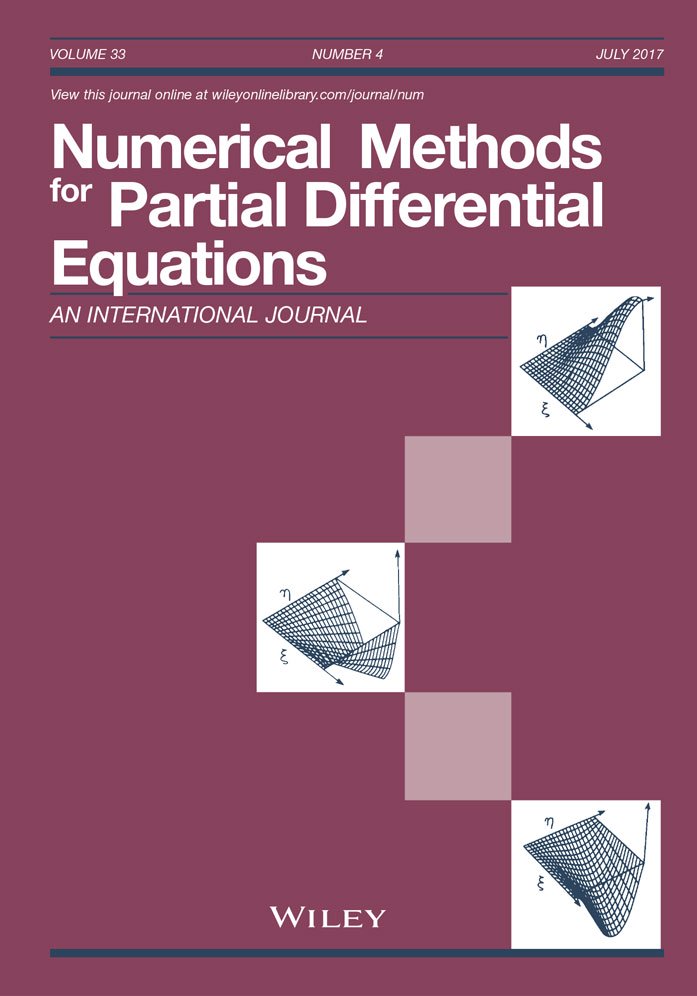
Angermann, Lutz; Knabner, Peter; Rupp, Andreas
Error estimates for completely discrete FEM in energy-type and weaker norms Journal Article Forthcoming
In: Numerical Methods for Partial Differential Equations, Forthcoming.
@article{AngermannKR24,
title = {Error estimates for completely discrete FEM in energy-type and weaker norms},
author = {Lutz Angermann and Peter Knabner and Andreas Rupp},
url = {https://onlinelibrary.wiley.com/doi/abs/10.1002/num.23106},
doi = {10.1002/num.23106},
year = {2024},
date = {2024-05-02},
urldate = {2024-05-02},
journal = {Numerical Methods for Partial Differential Equations},
abstract = {The paper presents error estimates within a unified abstract framework for the analysis of FEM for boundary value problems with linear diffusion-convection-reaction equations and boundary conditions of mixed type. Since neither conformity nor consistency properties are assumed, the method is called completely discrete. We investigate two different stabilized discretizations and obtain stability and optimal error estimates in energy-type norms and, by generalizing the Aubin-Nitsche technique, optimal error estimates in weaker norms.},
keywords = {},
pubstate = {forthcoming},
tppubtype = {article}
}
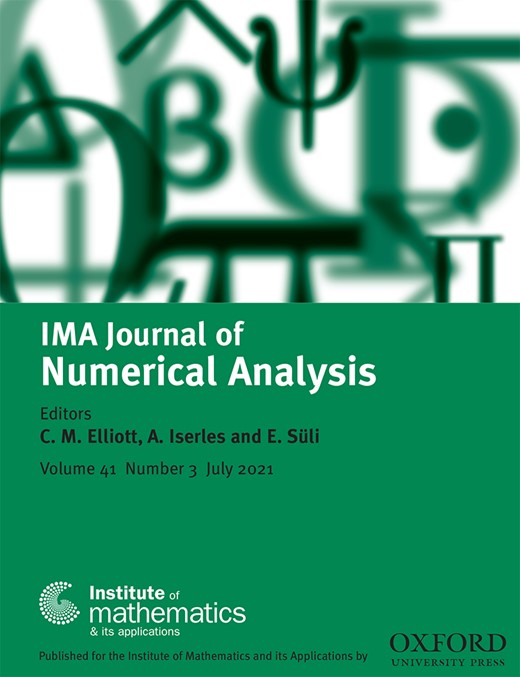
Lu, Peipei; Wang, Wei; Kanschat, Guido; Rupp, Andreas
Homogeneous multigrid for HDG applied to the Stokes equation Journal Article Forthcoming
In: IMA Journal of Numerical Analysis, Forthcoming, ISBN: 0272-4979.
@article{LuWKR23,
title = {Homogeneous multigrid for HDG applied to the Stokes equation},
author = {Peipei Lu and Wei Wang and Guido Kanschat and Andreas Rupp},
url = {https://academic.oup.com/imajna/advance-article-pdf/doi/10.1093/imanum/drad079/52422702/drad079.pdf},
doi = {10.1093/imanum/drad079},
isbn = {0272-4979},
year = {2023},
date = {2023-10-23},
urldate = {2023-10-23},
journal = {IMA Journal of Numerical Analysis},
abstract = {We propose a multigrid method to solve the linear system of equations arising from a hybrid discontinuous Galerkin (in particular, a single face hybridizable, a hybrid Raviart–Thomas, or a hybrid Brezzi–Douglas–Marini) discretization of a Stokes problem. Our analysis is centered around the augmented Lagrangian approach and we prove uniform convergence in this setting. Beyond this, we establish relations, which resemble those in Cockburn and Gopalakrishnan (2008, Error analysis of variable degree mixed methods for elliptic problems via hybridization. Math. Comput., 74, 1653–1677) for elliptic problems, between the approximates that are obtained by the single-face hybridizable, hybrid Raviart–Thomas and hybrid Brezzi–Douglas–Marini methods. Numerical experiments underline our analytical findings.},
keywords = {},
pubstate = {forthcoming},
tppubtype = {article}
}

Musch, Markus; Rupp, Andreas; Aizinger, Vadym; Knabner, Peter
Hybridizable discontinuous Galerkin method with mixed-order spaces for non-linear diffusion equations with internal jumps Journal Article
In: GEM - International Journal on Geomathematics, vol. 14, no. 18, pp. 25, 2023, ISSN: 1869-2680.
@article{MuschRAK23,
title = {Hybridizable discontinuous Galerkin method with mixed-order spaces for non-linear diffusion equations with internal jumps},
author = {Markus Musch and Andreas Rupp and Vadym Aizinger and Peter Knabner},
url = {https://link.springer.com/article/10.1007/s13137-023-00228-7},
doi = {10.1007/s13137-023-00228-7},
issn = {1869-2680},
year = {2023},
date = {2023-07-13},
urldate = {2023-07-13},
journal = {GEM - International Journal on Geomathematics},
volume = {14},
number = {18},
pages = {25},
abstract = {We formulate a hybridizable discontinuous Galerkin method for parabolic equations with non-linear tensor-valued coefficients and jump conditions (Henry’s law). The analysis of the proposed scheme indicates the optimal convergence order for mildly non-linear problems. The same order is also obtained in our numerical studies for simplified settings. A series of numerical experiments investigate the effect of choosing different order approximation spaces for various unknowns. },
keywords = {},
pubstate = {published},
tppubtype = {article}
}

Lu, Peipei; Rupp, Andreas; Kanschat, Guido
Two-level Schwarz methods for hybridizable discontinuous Galerkin methods Journal Article
In: Journal of Scientific Computing, vol. 95, no. 9, pp. 16, 2023, ISSN: 1573-7691.
@article{LuRK23,
title = {Two-level Schwarz methods for hybridizable discontinuous Galerkin methods},
author = {Peipei Lu and Andreas Rupp and Guido Kanschat},
url = {https://link.springer.com/article/10.1007/s10915-023-02121-9},
doi = {10.1007/s10915-023-02121-9},
issn = {1573-7691},
year = {2023},
date = {2023-02-15},
urldate = {2023-02-15},
journal = {Journal of Scientific Computing},
volume = {95},
number = {9},
pages = {16},
abstract = {In this paper, we propose two-level domain decomposition methods for hybridizable discontinuous Galerkin discretizations including hybridized local discontinuous Galerkin, Raviart–Thomas, and Brezzi–Douglas–Marini finite elements for Poisson’s equation. We study the additive Schwarz method as a preconditioner and the multiplicative method as an iterative solver. In our algorithm, the same discretization scheme is defined on the coarse mesh. In particular, we use the injection operator developed in [LuRK22a] and prove that the condition number of the preconditioned system only depends on the fraction between coarse and fine mesh sizes and the overlap width. Numerical experiments underline our analytical findings.},
keywords = {},
pubstate = {published},
tppubtype = {article}
}
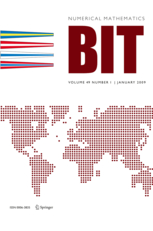
Hajduk, Hennes; Rupp, Andreas
Analysis of algebraic flux correction schemes for semi-discrete advection problems Journal Article
In: BIT Numerical Mathematics, vol. 63, no. 8, pp. 29, 2023, ISSN: 1572-9125.
@article{HajdukRK23,
title = {Analysis of algebraic flux correction schemes for semi-discrete advection problems},
author = {Hennes Hajduk and Andreas Rupp},
url = {https://doi.org/10.1007/s10543-023-00957-z},
doi = {10.1007/s10543-023-00957-z},
issn = {1572-9125},
year = {2023},
date = {2023-01-30},
urldate = {2023-01-30},
journal = {BIT Numerical Mathematics},
volume = {63},
number = {8},
pages = {29},
abstract = {Based on recent developments regarding the analysis of algebraic flux correction schemes, we consider a locally bound-preserving discretization of the time-dependent advection equation. Specifically, we analyze a monolithic convex limiting scheme based on piecewise (multi-)linear continuous finite elements in the semi-discrete formulation. To stabilize the discretization, we use low order time derivatives in the definition of raw antidiffusive fluxes. Our analytical investigation reveals that their limited counterparts should satisfy a certain compatibility condition. The conducted numerical experiments suggest that this prerequisite is satisfied unless the size of mesh elements is vastly different. We prove global-in-time existence of semi-discrete approximations and derive an a priori error estimate for finite time intervals with a worst-case convergence rate of 1/2 w. r. t. the L2 error. This rate is optimal in the setting under consideration because we allow all correction factors of the flux-corrected scheme to become zero. In this case, the algorithm reduces to the bound-preserving discrete upwinding method but the limited counterpart of this scheme converges much faster, in practice. Additional numerical experiments are performed to verify the provable convergence rate for a few variants of the scheme.},
keywords = {},
pubstate = {published},
tppubtype = {article}
}

Lu, Peipei; Rupp, Andreas; Kanschat, Guido
Homogeneous multigrid for embedded discontinuous Galerkin methods Journal Article
In: BIT Numerical Mathematics, vol. 62, iss. 3, pp. 1029–1048, 2022, ISSN: 1572-9125.
@article{LuRK22b,
title = {Homogeneous multigrid for embedded discontinuous Galerkin methods},
author = {Peipei Lu and Andreas Rupp and Guido Kanschat},
url = {https://link.springer.com/10.1007/s10543-021-00902-y},
doi = {10.1007/s10543-021-00902-y},
issn = {1572-9125},
year = {2022},
date = {2022-09-01},
urldate = {2022-09-01},
journal = {BIT Numerical Mathematics},
volume = {62},
issue = {3},
pages = {1029--1048},
abstract = {We formulate a multigrid method for an embedded discontinuous Galerkin (EDG) discretization scheme for Poisson’s equation. This multigrid method is homogeneous in the sense that it uses the same discretization scheme on all levels. In particular, we use the injection operator developed in Lu et al. (IMA J Numer Anal, 2021) for HDG and show optimal convergence rates under the assumption of elliptic regularity. Our analytical findings are underlined by numerical experiments.},
keywords = {},
pubstate = {published},
tppubtype = {article}
}

Lu, Peipei; Rupp, Andreas; Kanschat, Guido
Analysis of injection operators in geometric multigrid solvers for HDG methods Journal Article
In: SIAM Journal on Numerical Analysis, vol. 60, no. 4, pp. 2293–2317, 2022, ISSN: 0036-1429.
@article{LuRK22a,
title = {Analysis of injection operators in geometric multigrid solvers for HDG methods},
author = {Peipei Lu and Andreas Rupp and Guido Kanschat},
url = {https://epubs.siam.org/doi/abs/10.1137/21M1400110},
doi = {10.1137/21M1400110},
issn = {0036-1429},
year = {2022},
date = {2022-08-23},
urldate = {2022-08-23},
journal = {SIAM Journal on Numerical Analysis},
volume = {60},
number = {4},
pages = {2293--2317},
abstract = {Uniform convergence of the geometric multigrid V-cycle is proven for hybridized discontinuous Galerkin methods with a new set of assumptions on the injection operators from coarser to finer meshes. The scheme involves standard smoothers and local solvers which are bounded, convergent, and consistent. A weak version of elliptic regularity is used in the proofs. The new assumptions admit injection operators local to each coarse grid cell. Examples for admissible injection operators are given. The analysis applies to the hybridized local discontinuous Galerkin method, hybridized Raviart--Thomas, and hybridized Brezzi--Douglas--Marini mixed element methods. Numerical experiments are provided to confirm the theoretical results.},
keywords = {},
pubstate = {published},
tppubtype = {article}
}
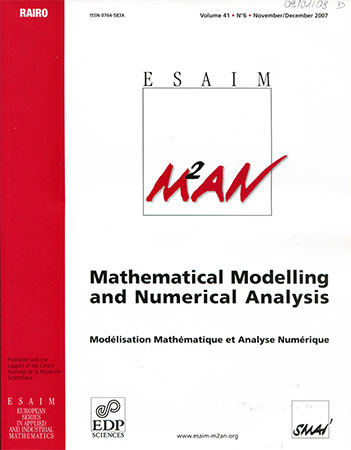
Rupp, Andreas; Gahn, Markus; Kanschat, Guido
Partial differential equations on hypergraphs and networks of surfaces: Derivation and hybrid discretizations Journal Article
In: ESAIM: Mathematical Modelling and Numerical Analysis, vol. 56, no. 2, pp. 505–528, 2022, ISSN: 0764-583X.
@article{RuppGK22,
title = {Partial differential equations on hypergraphs and networks of surfaces: Derivation and hybrid discretizations},
author = {Andreas Rupp and Markus Gahn and Guido Kanschat},
url = {https://www.esaim-m2an.org/component/article?access=doi&doi=10.1051/m2an/2022011},
doi = {10.1051/m2an/2022011},
issn = {0764-583X},
year = {2022},
date = {2022-02-24},
urldate = {2022-02-24},
journal = {ESAIM: Mathematical Modelling and Numerical Analysis},
volume = {56},
number = {2},
pages = {505--528},
abstract = {We introduce a general, analytical framework to express and to approximate partial differential equations (PDEs) numerically on graphs and networks of surfaces---generalized by the term hypergraphs. To this end, we consider PDEs on hypergraphs as singular limits of PDEs in networks of thin domains (such as fault planes, pipes, etc.), and we observe that (mixed) hybrid formulations offer useful tools to formulate such PDEs. Thus, our numerical framework is based on hybrid finite element methods (in particular, the class of hybrid discontinuous Galerkin methods).},
keywords = {},
pubstate = {published},
tppubtype = {article}
}
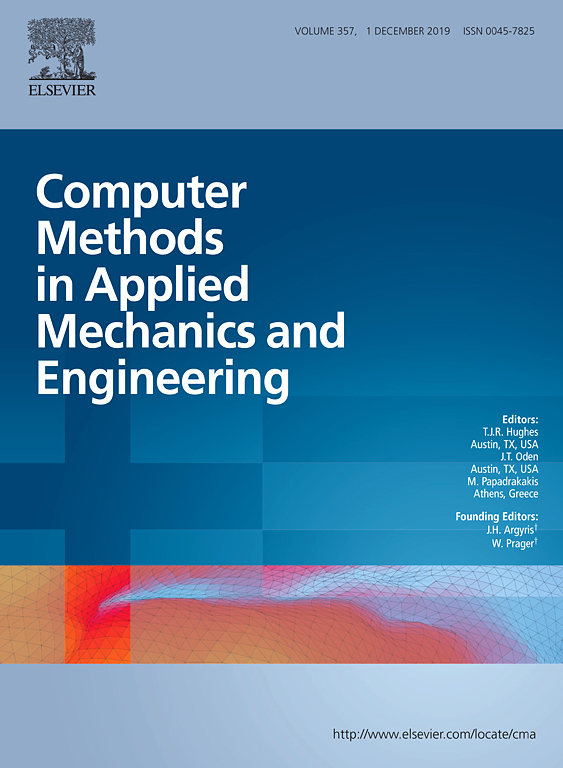
Kuzmin, Dmitri; Hajduk, Hennes; Rupp, Andreas
Limiter-based entropy stabilization of semi-discrete and fully discrete schemes for nonlinear hyperbolic problems Journal Article
In: Computer Methods in Applied Mechanics and Engineering, vol. 389, no. 114428, pp. 28, 2022, ISSN: 0045-7825.
@article{KuzminHR21,
title = {Limiter-based entropy stabilization of semi-discrete and fully discrete schemes for nonlinear hyperbolic problems},
author = {Dmitri Kuzmin and Hennes Hajduk and Andreas Rupp},
url = {https://www.sciencedirect.com/science/article/pii/S0045782521006708},
doi = {10.1016/j.cma.2021.114428},
issn = {0045-7825},
year = {2022},
date = {2022-02-01},
urldate = {2022-02-01},
journal = {Computer Methods in Applied Mechanics and Engineering},
volume = {389},
number = {114428},
pages = {28},
abstract = {The algebraic flux correction (AFC) schemes presented in this work constrain a standard continuous finite element discretization of a nonlinear hyperbolic problem to satisfy relevant maximum principles and entropy stability conditions. The desired properties are enforced by applying a limiter to antidiffusive fluxes that represent the difference between the high-order baseline scheme and a property-preserving approximation of Lax–Friedrichs type. In the first step of the limiting procedure, the given target fluxes are adjusted in a way that guarantees preservation of local and/or global bounds. In the second step, additional limiting is performed, if necessary, to ensure the validity of fully discrete and/or semi-discrete entropy inequalities. The limiter-based entropy fixes considered in this work are applicable to finite element discretizations of scalar hyperbolic equations and systems alike. The underlying inequality constraints are formulated using Tadmor’s entropy stability theory.
The proposed limiters impose entropy-conservative or entropy-dissipative bounds on the rate of entropy production by antidiffusive fluxes and Runge–Kutta (RK) time discretizations. Two versions of the fully discrete entropy fix are developed for this purpose. The first one incorporates temporal entropy production into the flux constraints, which makes them more restrictive and dependent on the time step. The second algorithm interprets the final stage of a high-order AFC-RK method as a constrained antidiffusive correction of an implicit low-order scheme (algebraic Lax–Friedrichs in space + backward Euler in time). In this case, iterative flux correction is required, but the inequality constraints are less restrictive and limiting can be performed using algorithms developed for the semi-discrete problem. To motivate the use of limiter-based entropy fixes, we prove a finite element version of the Lax–Wendroff theorem and perform numerical studies for standard test problems. In our numerical experiments, entropy-dissipative schemes converge to correct weak solutions of scalar conservation laws, of the Euler equations, and of the shallow water equations.},
keywords = {},
pubstate = {published},
tppubtype = {article}
}
The proposed limiters impose entropy-conservative or entropy-dissipative bounds on the rate of entropy production by antidiffusive fluxes and Runge–Kutta (RK) time discretizations. Two versions of the fully discrete entropy fix are developed for this purpose. The first one incorporates temporal entropy production into the flux constraints, which makes them more restrictive and dependent on the time step. The second algorithm interprets the final stage of a high-order AFC-RK method as a constrained antidiffusive correction of an implicit low-order scheme (algebraic Lax–Friedrichs in space + backward Euler in time). In this case, iterative flux correction is required, but the inequality constraints are less restrictive and limiting can be performed using algorithms developed for the semi-discrete problem. To motivate the use of limiter-based entropy fixes, we prove a finite element version of the Lax–Wendroff theorem and perform numerical studies for standard test problems. In our numerical experiments, entropy-dissipative schemes converge to correct weak solutions of scalar conservation laws, of the Euler equations, and of the shallow water equations.

Lu, Peipei; Rupp, Andreas; Kanschat, Guido
Homogeneous multigrid for HDG Journal Article
In: IMA Journal of Numerical Analysis, vol. 42, iss. 4, pp. 3135–3153, 2021, ISSN: 0272-4979.
@article{LuRK21,
title = {Homogeneous multigrid for HDG},
author = {Peipei Lu and Andreas Rupp and Guido Kanschat},
url = {https://academic.oup.com/imajna/advance-article-abstract/doi/10.1093/imanum/drab055/6323813?redirectedFrom=fulltext},
doi = {10.1093/imanum/drab055},
issn = {0272-4979},
year = {2021},
date = {2021-07-19},
urldate = {2021-07-19},
journal = {IMA Journal of Numerical Analysis},
volume = {42},
issue = {4},
pages = {3135--3153},
abstract = {We introduce a multigrid method that is homogeneous in the sense that it uses the same hybridizable discontinuous Galerkin (HDG) discretization scheme for Poisson’s equation on all levels. In particular, we construct a stable injection operator and prove optimal convergence of the method under the assumption of elliptic regularity. Numerical experiments underline our analytical findings.},
keywords = {},
pubstate = {published},
tppubtype = {article}
}
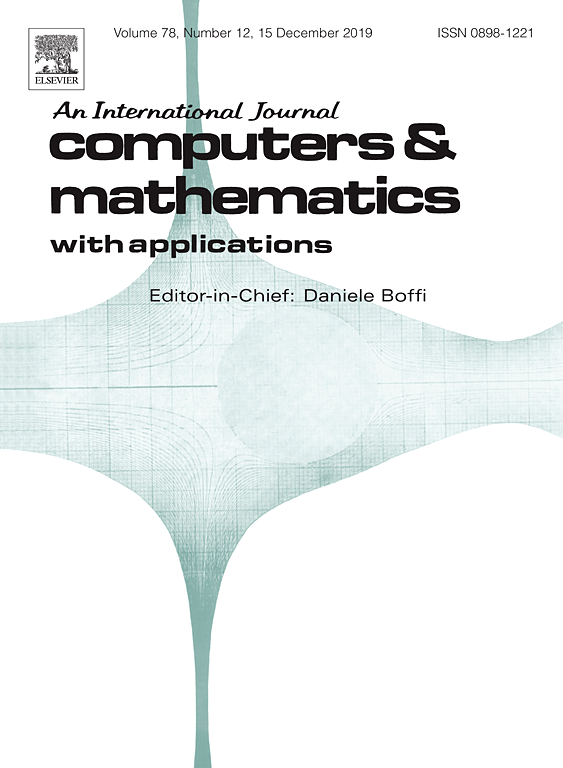
Rupp, Andreas; Hauck, Moritz; Aizinger, Vadym
A subcell-enriched Galerkin method for advection problems Journal Article
In: Computers & Mathematics with Applications, vol. 93, pp. 120–129, 2021, ISSN: 0898-1221.
@article{RuppHA20,
title = {A subcell-enriched Galerkin method for advection problems},
author = {Andreas Rupp and Moritz Hauck and Vadym Aizinger},
url = {https://www.sciencedirect.com/science/article/pii/S0898122121001425},
doi = {10.1016/j.camwa.2021.04.010},
issn = {0898-1221},
year = {2021},
date = {2021-07-01},
urldate = {2021-07-01},
journal = {Computers & Mathematics with Applications},
volume = {93},
pages = {120--129},
abstract = {In this work, we introduce a generalization of the enriched Galerkin (EG) method. The key feature of our scheme is an adaptive two-mesh approach that, in addition to the standard enrichment of a conforming finite element discretization via discontinuous degrees of freedom, allows to subdivide selected (e.g. troubled) mesh cells in a non-conforming fashion and to use further discontinuous enrichment on this finer submesh. We prove stability and sharp a priori error estimates for a linear advection equation by using a specially tailored projection and conducting some parts of a standard convergence analysis for both meshes. By allowing an arbitrary degree of enrichment on both, the coarse and the fine mesh (also including the case of no enrichment), our analysis technique is very general in the sense that our results cover the range from the standard continuous finite element method to the standard discontinuous Galerkin (DG) method with (or without) local subcell enrichment. Numerical experiments confirm our analytical results and indicate good robustness of the proposed method.},
keywords = {},
pubstate = {published},
tppubtype = {article}
}

Reuter, Balthasar; Hajduk, Hennes; Rupp, Andreas; Frank, Florian; Aizinger, Vadym; Knabner, Peter
FESTUNG 1.0: Overview, usage, and example applications of the Matlab / GNU Octave toolbox for discontinuous Galerkin methods Journal Article
In: Computers & Mathematics with Applications, vol. 81, pp. 3–41, 2021, ISSN: 0898-1221.
@article{ReuterHRFAK20,
title = {FESTUNG 1.0: Overview, usage, and example applications of the Matlab / GNU Octave toolbox for discontinuous Galerkin methods},
author = {Balthasar Reuter and Hennes Hajduk and Andreas Rupp and Florian Frank and Vadym Aizinger and Peter Knabner},
url = {http://www.sciencedirect.com/science/article/pii/S0898122120303254},
doi = {10.1016/j.camwa.2020.08.018},
issn = {0898-1221},
year = {2021},
date = {2021-01-01},
urldate = {2021-01-01},
journal = {Computers & Mathematics with Applications},
volume = {81},
pages = {3--41},
abstract = {The present work documents the current state of development for our MATLAB/GNU Octave-based open source toolbox FESTUNG (Finite Element Simulation Toolbox for UNstructured Grids). The goal of this project is to design a user-friendly, research-oriented, yet computationally efficient software tool for solving partial differential equations (PDEs). Since the release of its first version, FESTUNG has been actively used for research and teaching purposes such as the design of novel algorithms and discretization schemes, benchmark studies, or just providing students with an easy-to-learn software package to study advanced numerical techniques and good programming practices. For spatial discretization, the package employs various discontinuous Galerkin (DG) methods, while different explicit, implicit, or semi-implicit Runge–Kutta schemes can be used for time stepping. The current publication discusses the most important aspects of our toolbox such as the code design concepts and various discretization procedures illustrated in some detail using a standard advection–diffusion–reaction equation. Moreover, we present selected applications already supported in FESTUNG including solvers for the two-dimensional shallow-water equations, the Cahn–Hilliard equation, and a coupled multi-physics model of free surface/subsurface flow.},
keywords = {},
pubstate = {published},
tppubtype = {article}
}

Hauck, Moritz; Aizinger, Vadym; Frank, Florian; Hajduk, Hennes; Rupp, Andreas
Enriched Galerkin method for the shallow-water equations Journal Article
In: GEM - International Journal on Geomathematics, vol. 11, no. 31, pp. 25, 2020, ISSN: 1869-2680.
@article{HauckAFHR20,
title = {Enriched Galerkin method for the shallow-water equations},
author = {Moritz Hauck and Vadym Aizinger and Florian Frank and Hennes Hajduk and Andreas Rupp},
url = {https://link.springer.com/article/10.1007/s13137-020-00167-7},
doi = {10.1007/s13137-020-00167-7},
issn = {1869-2680},
year = {2020},
date = {2020-11-21},
urldate = {2020-11-21},
journal = {GEM - International Journal on Geomathematics},
volume = {11},
number = {31},
pages = {25},
abstract = {This work presents an enriched Galerkin (EG) discretization for the two-dimensional shallow-water equations. The EG finite element spaces are obtained by extending the approximation spaces of the classical finite elements by discontinuous functions supported on elements. The simplest EG space is constructed by enriching the piecewise linear continuous Galerkin space with discontinuous, element-wise constant functions. Similar to discontinuous Galerkin (DG) discretizations, the EG scheme is locally conservative, while, in multiple space dimensions, the EG space is significantly smaller than that of the DG method. This implies a lower number of degrees of freedom compared to the DG method. The EG discretization presented for the shallow-water equations is well-balanced, in the sense that it preserves lake-at-rest configurations. We evaluate the method’s robustness and accuracy using various analytical and realistic problems and compare the results to those obtained using the DG method. Finally, we briefly discuss implementation aspects of the EG method within our MATLAB / GNU Octave framework FESTUNG.},
keywords = {},
pubstate = {published},
tppubtype = {article}
}
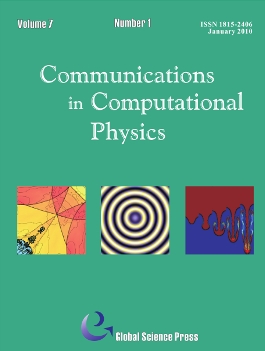
Reuter, Balthasar; Rupp, Andreas; Aizinger, Vadym; Frank, Florian; Knabner, Peter
FESTUNG: A MATLAB/GNU Octave toolbox for the discontinuous Galerkin method. Part IV: Generic problem framework and model-coupling interface Journal Article
In: Communications in Computational Physics, vol. 28, no. 2, pp. 827–876, 2020, ISSN: 1991-7120.
@article{ReuterRAFK20,
title = {FESTUNG: A MATLAB/GNU Octave toolbox for the discontinuous Galerkin method. Part IV: Generic problem framework and model-coupling interface},
author = {Balthasar Reuter and Andreas Rupp and Vadym Aizinger and Florian Frank and Peter Knabner},
url = {http://global-sci.org/intro/article_detail/cicp/16955.html},
doi = {10.4208/cicp.OA-2019-0132},
issn = {1991-7120},
year = {2020},
date = {2020-08-01},
urldate = {2020-08-01},
journal = {Communications in Computational Physics},
volume = {28},
number = {2},
pages = {827--876},
abstract = {This is the fourth installment in our series on implementing the discontinuous Galerkin (DG) method as an open source MATLAB / GNU Octave toolbox. Similarly to its predecessors, this part presents new features for application developers employing DG methods and follows our strategy of relying on fully vectorized constructs and supplying a comprehensive documentation. The specific focus of the current work is the newly added generic problem implementation framework and the highly customizable model-coupling interface for multi-domain and multi-physics simulation tools based on this framework. The functionality of the coupling interface in the FESTUNG toolbox is illustrated using a two-way coupled free-surface / groundwater flow system as an example application.},
keywords = {},
pubstate = {published},
tppubtype = {article}
}

Rupp, Andreas; Lee, Sanghyun
In: Journal of Scientific Computing, vol. 84, no. 9, pp. 25, 2020, ISSN: 1573-7691.
@article{RuppL20,
title = {Continuous Galerkin and enriched Galerkin methods with arbitrary order discontinuous trial functions for the elliptic and parabolic problems with jump conditions},
author = {Andreas Rupp and Sanghyun Lee},
url = {https://link.springer.com/article/10.1007/s10915-020-01255-4#citeas},
doi = {10.1007/s10915-020-01255-4},
issn = {1573-7691},
year = {2020},
date = {2020-06-23},
urldate = {2020-06-23},
journal = {Journal of Scientific Computing},
volume = {84},
number = {9},
pages = {25},
abstract = {In this paper, a new version of the enriched Galerkin (EG) method for elliptic and parabolic equations is presented and analyzed, which is capable of dealing with a jump condition along a submanifold Gamma. The jump condition is known as Henry’s law in a stationary diffusion process. Here, the novel EG finite element method is constructed by enriching the continuous Galerkin finite element space by not only piecewise constants but also with piecewise polynomials with an arbitrary order. In addition, we extend the proposed method to consider new versions of a continuous Galerkin (CG) and a discontinuous Galerkin (DG) finite element method. The presented uniform analyses for CG, DG, and EG account for a spatially and temporally varying diffusion tensor which is also allowed to have a jump at Gamma and gives optimal convergence results. Several numerical experiments verify the presented analyses and illustrate the capability of the proposed methods.},
keywords = {},
pubstate = {published},
tppubtype = {article}
}
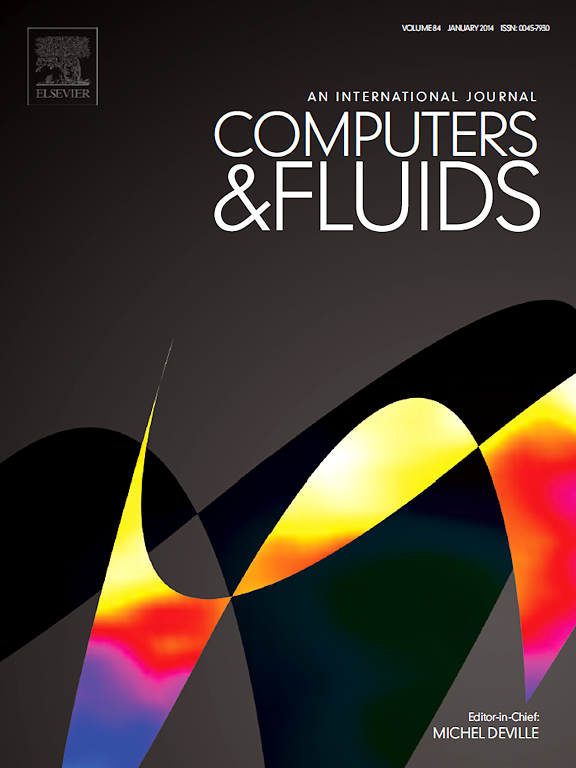
Kuzmin, Dmitri; Hajduk, Hennes; Rupp, Andreas
Locally bound-preserving enriched Galerkin methods for the linear advection equation Journal Article
In: Computers & Fluids, vol. 205, no. 104525, pp. 15, 2020, ISSN: 0045-7930.
@article{KuzminHR20,
title = {Locally bound-preserving enriched Galerkin methods for the linear advection equation},
author = {Dmitri Kuzmin and Hennes Hajduk and Andreas Rupp},
url = {https://www.sciencedirect.com/science/article/pii/S0045793020300992},
doi = {10.1016/j.compfluid.2020.104525},
issn = {0045-7930},
year = {2020},
date = {2020-06-15},
urldate = {2020-06-15},
journal = {Computers & Fluids},
volume = {205},
number = {104525},
pages = {15},
abstract = {In this work, we introduce algebraic flux correction schemes for enriched (P1⊕P0 and Q1⊕P0) Galerkin discretizations of the linear advection equation. The piecewise-constant component stabilizes the continuous Galerkin approximation without introducing free parameters. However, violations of discrete maximum principles are possible in the neighborhood of discontinuities and steep fronts. To keep the cell averages and the degrees of freedom of the continuous P1/Q1 component in the admissible range, we limit the fluxes and element contributions, the complete removal of which would correspond to first-order upwinding. The first limiting procedure that we consider in this paper is based on the flux-corrected transport (FCT) paradigm. It belongs to the family of predictor-corrector algorithms and requires the use of small time steps. The second limiting strategy is monolithic and produces nonlinear problems with well-defined residuals. This kind of limiting is well suited for stationary and time-dependent problems alike. The need for inverting consistent mass matrices in explicit strong stability preserving Runge-Kutta time integrators is avoided by reconstructing nodal time derivatives from cell averages. Numerical studies are performed for standard 2D test problems.},
keywords = {},
pubstate = {published},
tppubtype = {article}
}

Alecsa, Cristian Daniel; Boros, Imre; Frank, Florian; Knabner, Peter; Nechita, Mihai; Prechtel, Alexander; Rupp, Andreas; Suciu, Nicolae
Numerical benchmark study for flow in highly heterogeneous aquifers Journal Article
In: Advances in Water Resources, vol. 138, no. 103558, pp. 16, 2020, ISSN: 0309-1708.
@article{AlecsaBFKNPRS20,
title = {Numerical benchmark study for flow in highly heterogeneous aquifers},
author = {Cristian Daniel Alecsa and Imre Boros and Florian Frank and Peter Knabner and Mihai Nechita and Alexander Prechtel and Andreas Rupp and Nicolae Suciu},
url = {https://www.sciencedirect.com/science/article/pii/S030917081930658X},
doi = {10.1016/j.advwatres.2020.103558},
issn = {0309-1708},
year = {2020},
date = {2020-04-01},
urldate = {2020-04-01},
journal = {Advances in Water Resources},
volume = {138},
number = {103558},
pages = {16},
abstract = {This article presents numerical investigations on accuracy and convergence properties of several numerical approaches for simulating steady state flows in heterogeneous aquifers. Finite difference, finite element, discontinuous Galerkin, spectral, and random walk methods are tested on one- and two-dimensional benchmark flow problems. Realizations of log-normal hydraulic conductivity fields are generated by Kraichnan algorithms in closed form as finite sums of random periodic modes, which allow direct code verification by comparisons with manufactured reference solutions. The quality of the methods is assessed for increasing number of random modes and for increasing variance of the log-hydraulic conductivity fields with Gaussian and exponential correlation. Experimental orders of convergence are calculated from successive refinements of the grid. The numerical methods are further validated by comparisons between statistical inferences obtained from Monte Carlo ensembles of numerical solutions and theoretical first-order perturbation results. It is found that while for Gaussian correlation of the log-conductivity field all the methods perform well, in exponential case their accuracy deteriorates and, for large variance and number of modes, the benchmark problems are practically not tractable with reasonably large computing resources, for all the methods considered in this study.},
keywords = {},
pubstate = {published},
tppubtype = {article}
}

Frank, Florian; Rupp, Andreas; Kuzmin, Dmitri
Bound-preserving flux limiting schemes for DG discretizations of conservation laws with applications to the Cahn–Hilliard equation Journal Article
In: Computer Methods in Applied Mechanics and Engineering, vol. 359, no. 112665, pp. 25, 2020, ISSN: 0045-7825.
@article{FrankRK20,
title = {Bound-preserving flux limiting schemes for DG discretizations of conservation laws with applications to the Cahn–Hilliard equation},
author = {Florian Frank and Andreas Rupp and Dmitri Kuzmin},
url = {https://www.sciencedirect.com/science/article/pii/S004578251930550X},
doi = {10.1016/j.cma.2019.112665},
issn = {0045-7825},
year = {2020},
date = {2020-02-01},
urldate = {2020-02-01},
journal = {Computer Methods in Applied Mechanics and Engineering},
volume = {359},
number = {112665},
pages = {25},
abstract = {Many mathematical models of computational fluid dynamics involve transport of conserved quantities, which must lie in a certain range to be physically meaningful. The analytical or numerical solution u of a scalar conservation law is said to be bound-preserving if global bounds u_min and u_max exist such that u_min ≤ u ≤ u_max holds in the domain of definition. These bounds must be known a priori. To enforce such inequality constraints at least for element averages in the context of discontinuous Galerkin (DG) methods, the numerical fluxes must be defined and constrained in an appropriate manner. In this work, we introduce a general framework for calculating fluxes that produce non-oscillatory DG approximations and preserve relevant global bounds for element averages even if the analytical solution of the PDE violates them due to modeling errors. The proposed methodology is based on a combination of flux and slope limiting. The (optional) slope limiter adjusts the gradients to impose local bounds on pointwise values of the high-order DG solution, which is used to calculate the fluxes. The flux limiter constrains changes of element averages so as to prevent violations of global bounds. Since manipulations of the target flux may introduce a consistency error, it is essential to guarantee that physically admissible fluxes remain unchanged. We propose two kinds of flux limiters, which meet this requirement. The first one is of monolithic type and its time-implicit version requires the iterative solution of a nonlinear problem. Only a fully converged solution is provably bound-preserving. The time-explicit version of this limiter is subject to a time step restriction, which we derive in this article. The second limiter is an iterative version of the multidimensional flux-corrected transport (FCT) algorithm and works as postprocessed correction scheme. This fractional step limiting approach guarantees that each iterate is bound-preserving but avoidable consistency errors may occur if the iterative process is terminated too early. Each iterate depends only on local information of the previous iterate. This concept of limiting the numerical fluxes is also applicable to finite volume methods. Practical applicability of the proposed flux limiters as well as the benefits of using an optional slope limiter are demonstrated by numerical studies for the advection equation (hyperbolic, linear) and the Cahn–Hilliard equation (parabolic, nonlinear) for first-order polynomials. While both flux limiters work for arbitrary order polynomials, we discuss the construction of bound-preserving slope limiters, and show numerical studies only for first-order polynomials.},
keywords = {},
pubstate = {published},
tppubtype = {article}
}
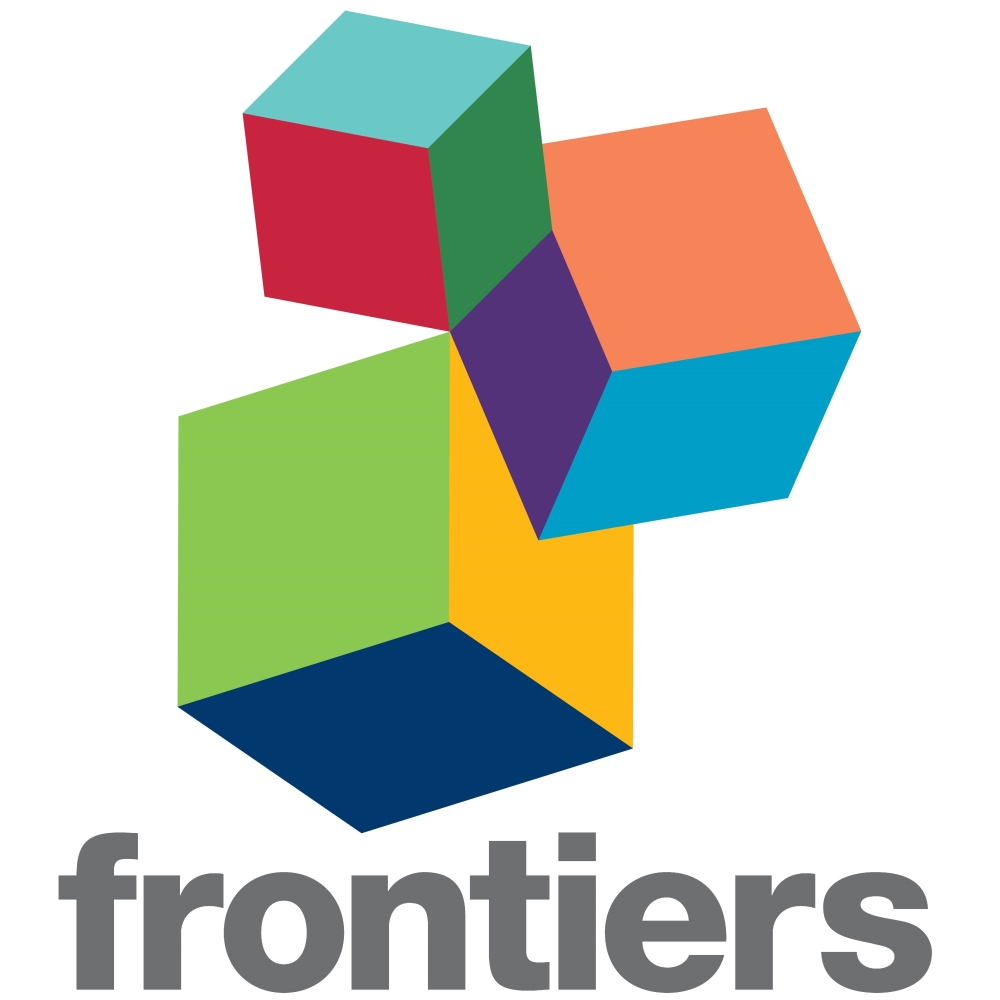
Rupp, Andreas; Guhra, Tom; Meier, Andreas; Prechtel, Alexander; Ritschel, Thomas; Ray, Nadja; Totsche, Kai Uwe
Application of a cellular automaton method to model the structure formation in soils under saturated conditions: A mechanistic approach Journal Article
In: Frontiers in Environmental Science, vol. 7, no. 170, pp. 11, 2019, ISSN: 2296-665X.
@article{RuppGMPRRT19,
title = {Application of a cellular automaton method to model the structure formation in soils under saturated conditions: A mechanistic approach},
author = {Andreas Rupp and Tom Guhra and Andreas Meier and Alexander Prechtel and Thomas Ritschel and Nadja Ray and Kai Uwe Totsche},
url = {https://www.frontiersin.org/article/10.3389/fenvs.2019.00170},
doi = {10.3389/fenvs.2019.00170},
issn = {2296-665X},
year = {2019},
date = {2019-11-01},
urldate = {2019-11-01},
journal = {Frontiers in Environmental Science},
volume = {7},
number = {170},
pages = {11},
abstract = {Soil functions are closely related to the structure of soil microaggregates. Yet, the mechanisms controlling the establishment of soil structure are diverse and partly unknown. Hence, the understanding of soil processes and functions requires the connection of the concepts on the formation and consolidation of soil structural elements across scales that are hard to observe experimentally. At the bottom level, the dynamics of microaggregate development and restructuring build the basis for transport phenomena at the continuum scale. By modeling the interactions of specific minerals and/or organic matter, we aim to identify the mechanisms that control the evolution of structure and establishment of stationary aggregate properties. We present a mechanistic framework based on a cellular automaton model to simulate the interplay between the prototypic building units of soil microaggregates quartz, goethite, and illite subject to attractive and repulsive electrostatic interaction forces. The resulting structures are quantified by morphological measures. We investigated shielding effects due to charge neutralization and the aggregate growth rate in response to the net system charge. We found that the fraction as well as the size of the interacting oppositely charged constituents control the size, shape, and amount of occurring aggregates. Furthermore, the concentration in terms of the liquid solid ratio has been shown to increase the aggregation rate. We further adopt the model for an assessment of the temporal evolution of aggregate formation due to successive formation of particle dimers at early stages in comparison to higher order aggregates at later stages. With that we show the effect of composition, charge, size ratio, time, and concentration on microaggregate formation by the application of a mechanistic model which also provides predictions for soil aggregation behavior in case an observation is inhibited by experimental limitations.},
keywords = {},
pubstate = {published},
tppubtype = {article}
}
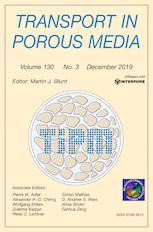
Schulz, Raphael; Ray, Nadja; Zech, Simon; Rupp, Andreas; Knabner, Peter
Beyond Kozeny–Carman: Predicting the permeability in porous media Journal Article
In: Transport in Porous Media, vol. 130, no. 2, pp. 487–512, 2019, ISSN: 1573-1634.
@article{SchulzRZRK19,
title = {Beyond Kozeny–Carman: Predicting the permeability in porous media},
author = {Raphael Schulz and Nadja Ray and Simon Zech and Andreas Rupp and Peter Knabner},
url = {https://link.springer.com/article/10.1007%2Fs11242-019-01321-y},
doi = {10.1007/s11242-019-01321-y},
issn = {1573-1634},
year = {2019},
date = {2019-11-01},
urldate = {2019-11-01},
journal = {Transport in Porous Media},
volume = {130},
number = {2},
pages = {487--512},
abstract = {Various processes such as heterogeneous reactions or biofilm growth alter a porous medium's underlying geometric structure. This significantly affects its hydrodynamic parameters, in particular the medium's effective permeability. An accurate, quantitative description of the permeability is, however, essential for predictive flow and transport modeling. Well-established relations such as the Kozeny–Carman equation or power law approaches including fitting parameters relate the porous medium's porosity to a scalar permeability coefficient. Opposed to this, upscaling methods directly enable calculating the full, potentially anisotropic, permeability tensor. As input, only the geometric information in terms of a representative elementary volume is needed. To compute the porosity–permeability relations, supplementary cell problems must be solved numerically on this volume and their solutions must be integrated. We apply this approach to provide easy-to-use quantitative porosity–permeability relations that are based on representative single grain, platy, blocky, prismatic soil structures, porous networks, and real geometries obtained from CT-data. As a discretization method, we use discontinuous Galerkin method on structured grids. To make the relations explicit, interpolation of the obtained data is used. We compare the outcome with the well-established relations and investigate the ranges of the validity. From our investigations, we conclude whether Kozeny–Carman-type or power law-type porosity–permeability relations are more reasonable for various prototypic representative elementary volumes. Finally, we investigate the impact of a microporous solid matrix onto the permeability.},
keywords = {},
pubstate = {published},
tppubtype = {article}
}

Reuter, Balthasar; Rupp, Andreas; Aizinger, Vadym; Knabner, Peter
Discontinuous Galerkin method for coupling hydrostatic free surface flows to saturated subsurface systems Journal Article
In: Computers & Mathematics with Applications, vol. 77, no. 9, pp. 2291–2309, 2019, ISSN: 0898-1221.
@article{ReuterRAK19,
title = {Discontinuous Galerkin method for coupling hydrostatic free surface flows to saturated subsurface systems},
author = {Balthasar Reuter and Andreas Rupp and Vadym Aizinger and Peter Knabner},
url = {https://www.sciencedirect.com/science/article/pii/S0898122118307120},
doi = {10.1016/j.camwa.2018.12.020},
issn = {0898-1221},
year = {2019},
date = {2019-05-01},
urldate = {2019-05-01},
journal = {Computers & Mathematics with Applications},
volume = {77},
number = {9},
pages = {2291--2309},
abstract = {We formulate a coupled surface/subsurface flow model that relies on hydrostatic equations with free surface in the free flow domain and on Darcy’s law in the subsurface. The model is discretized using the local discontinuous Galerkin method, and a statement of discrete energy stability is proved for the fully non-linear coupled system. The performance of the proposed scheme is illustrated by a numerical convergence study and a realistic example.},
keywords = {},
pubstate = {published},
tppubtype = {article}
}

Rupp, Andreas; Totsche, Kai Uwe; Prechtel, Alexander; Ray, Nadja
Discrete-continuum multiphase model for structure formation in soils including electrostatic effects Journal Article
In: Frontiers in Environmental Science, vol. 6, no. 96, pp. 13, 2018, ISSN: 2296-665X.
@article{RuppTPR18,
title = {Discrete-continuum multiphase model for structure formation in soils including electrostatic effects},
author = {Andreas Rupp and Kai Uwe Totsche and Alexander Prechtel and Nadja Ray},
url = {https://www.frontiersin.org/article/10.3389/fenvs.2018.00096},
doi = {10.3389/fenvs.2018.00096},
issn = {2296-665X},
year = {2018},
date = {2018-09-25},
urldate = {2018-09-25},
journal = {Frontiers in Environmental Science},
volume = {6},
number = {96},
pages = {13},
abstract = {Structure formation and self organization in soils determine soil functions and regulate soil processes. Mathematically based modeling can facilitate the understanding of organizing mechanisms at different scales, provided that the major driving forces are taken into account. In this research we present an extension of the mechanistic model for transport, biomass development and solid restructuring that was proposed in a former publication of the authors. Three main extensions are implemented. First, arbitrary shapes for the building units (e.g., spherical, needle-like, or platy particles), and also their compositions are incorporated into the model. Second, a gas phase is included in addition to solid, biofilm, and fluid phases. Interaction rules within and between the phases are prescribed using a cellular automaton method (CAM) and a system of partial differential equations (PDEs). These result in a structural self organization of the respective phases which define the time-dependent composition of the computational domain. Within the non-solid phases, chemical species may diffuse and react. In particular a kinetic Langmuir isotherm for heterogeneous surface reactions and a Henry condition for the transfer from/into the gas phase are applied. As third important model extension charges and charge conservation laws are included into the model for both the solid phase and ions in solution, as electrostatic attraction is a major driving force for aggregation. The ions move obeying the Nernst-Planck equations. A fully implicit local discontinuous Galerkin (LDG) method is applied to solve the resulting equation systems. The operational, comprehensive model allows to study structure formation as a function of the size and shape of the solid particles. Moreover, the effect of attraction and repulsion by charges is thoroughly discussed. The presented model is a first step to capture various aspects of structure formation and self organization in soils, it is a process-based tool to study the interplay of relevant mechanisms in silico.},
keywords = {},
pubstate = {published},
tppubtype = {article}
}

Ray, Nadja; Rupp, Andreas; Schulz, Raphael; Knabner, Peter
Old and new approaches predicting the diffusion in porous media Journal Article
In: Transport in Porous Media, vol. 124, no. 3, pp. 803–824, 2018, ISSN: 1573-1634.
@article{RayRSK18,
title = {Old and new approaches predicting the diffusion in porous media},
author = {Nadja Ray and Andreas Rupp and Raphael Schulz and Peter Knabner},
url = {https://link.springer.com/article/10.1007%2Fs11242-018-1099-x},
doi = {10.1007/s11242-018-1099-x},
issn = {1573-1634},
year = {2018},
date = {2018-09-01},
urldate = {2018-09-01},
journal = {Transport in Porous Media},
volume = {124},
number = {3},
pages = {803--824},
abstract = {An accurate quantitative description of the diffusion coefficient in a porous medium is essential for predictive transport modeling. Well-established relations, such as proposed by Buckingham, Penman, and Millington--Quirk, relate the scalar diffusion coefficient to the porous medium's porosity. To capture the porous medium's structure in more detail, further models include fitting parameters, geometric, or shape factors. Some models additionally account for the tortuosity, e.g., via Archie's law. A validation of such models has been carried out mainly via experiments relating the proposed description to a specific class of porous media (by means of parameter fitting). Contrary to these approaches, upscaling methods directly enable calculating the full, potentially anisotropic, effective diffusion tensor without any fitting parameters. As input only the geometric information in terms of a representative elementary volume is needed. To compute the diffusion--porosity relations, supplementary cell problems must be solved numerically and their (flux) solutions must be integrated. We apply this approach to provide easy-to-use quantitative diffusion--porosity relations that are based on representative single grain, platy, blocky, prismatic soil structures, porous networks, or random porous media. As a discretization method, we use the discontinuous Galerkin method on structured grids. To make the relations explicit, interpolation of the obtained data is used. We furthermore compare the obtained diffusion--porosity relations with the well-established relations mentioned above and also with the well-known Voigt--Reiss or Hashin--Shtrikman bounds. We discuss the ranges of validity and further provide the explicit relations between the diffusion and surface area and comment on the role of a tortuosity--porosity relation.},
keywords = {},
pubstate = {published},
tppubtype = {article}
}
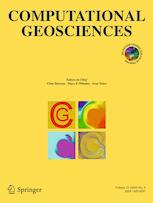
Rupp, Andreas; Knabner, Peter; Dawson, Clint
A local discontinuous Galerkin scheme for Darcy flow with internal jumps Journal Article
In: Computational Geosciences, vol. 22, no. 4, pp. 1149–1159, 2018, ISSN: 1573-1499.
@article{RuppKD18,
title = {A local discontinuous Galerkin scheme for Darcy flow with internal jumps},
author = {Andreas Rupp and Peter Knabner and Clint Dawson},
url = {https://link.springer.com/article/10.1007%2Fs10596-018-9743-7#citeas},
doi = {10.1007/s10596-018-9743-7},
issn = {1573-1499},
year = {2018},
date = {2018-08-01},
urldate = {2018-08-01},
journal = {Computational Geosciences},
volume = {22},
number = {4},
pages = {1149--1159},
abstract = {We present a new version of the local discontinuous Galerkin method which is capable of dealing with jump conditions along a submanifold Gamma (i.e., Henry's Law) in instationary Darcy flow. Our analysis accounts for a spatially and temporally varying, non-linear permeability tensor in all estimates which is also allowed to have a jump at Gamma and gives a convergence order result for the primary and the flux unknowns. In addition to this, different approximation spaces for the primary and the flux unknowns are investigated. The results imply that the most efficient choice is to choose the degree of the approximation space for the flux unknowns one less than that of the primary unknown. The only stabilization in the proposed scheme is represented by a penalty term in the primary unknown.},
keywords = {},
pubstate = {published},
tppubtype = {article}
}

Aizinger, Vadym; Rupp, Andreas; Schütz, Jochen; Knabner, Peter
Analysis of a mixed discontinuous Galerkin method for instationary Darcy flow Journal Article
In: Computational Geosciences, vol. 22, no. 1, pp. 179–194, 2018, ISSN: 1573-1499.
@article{AizingerRSK18,
title = {Analysis of a mixed discontinuous Galerkin method for instationary Darcy flow},
author = {Vadym Aizinger and Andreas Rupp and Jochen Schütz and Peter Knabner},
url = {https://link.springer.com/article/10.1007%2Fs10596-017-9682-8},
doi = {10.1007/s10596-017-9682-8},
issn = {1573-1499},
year = {2018},
date = {2018-02-01},
urldate = {2018-02-01},
journal = {Computational Geosciences},
volume = {22},
number = {1},
pages = {179--194},
abstract = {We present an a priori stability and convergence analysis of a new mixed discontinuous Galerkin scheme applied to the instationary Darcy problem. The analysis accounts for a spatially and temporally varying permeability tensor in all estimates. The proposed method is stabilized using penalty terms in the primary and the flux unknowns.},
keywords = {},
pubstate = {published},
tppubtype = {article}
}

Ray, Nadja; Rupp, Andreas; Prechtel, Alexander
Discrete-continuum multiscale model for transport, biomass development and solid restructuring in porous media Journal Article
In: Advances in Water Resources, vol. 107, pp. 393–404, 2017, ISSN: 0309-1708.
@article{RayRP17,
title = {Discrete-continuum multiscale model for transport, biomass development and solid restructuring in porous media},
author = {Nadja Ray and Andreas Rupp and Alexander Prechtel},
url = {https://www.sciencedirect.com/science/article/abs/pii/S0309170816304870},
doi = {10.1016/j.advwatres.2017.04.001},
issn = {0309-1708},
year = {2017},
date = {2017-09-01},
urldate = {2017-09-01},
journal = {Advances in Water Resources},
volume = {107},
pages = {393--404},
abstract = {Upscaling transport in porous media including both biomass development and simultaneous structural changes in the solid matrix is extremely challenging. This is because both affect the medium’s porosity as well as mass transport parameters and flow paths. We address this challenge by means of a multiscale model. At the pore scale, the local discontinuous Galerkin (LDG) method is used to solve differential equations describing particularly the bacteria’s and the nutrient’s development. Likewise, a sticky agent tightening together solid or bio cells is considered. This is combined with a cellular automaton method (CAM) capturing structural changes of the underlying computational domain stemming from biomass development and solid restructuring. Findings from standard homogenization theory are applied to determine the medium’s characteristic time- and space-dependent properties. Investigating these results enhances our understanding of the strong interplay between a medium’s functional properties and its geometric structure. Finally, integrating such properties as model parameters into models defined on a larger scale enables reflecting the impact of pore scale processes on the larger scale.},
keywords = {},
pubstate = {published},
tppubtype = {article}
}

Rupp, Andreas; Knabner, Peter
Convergence order estimates of the local discontinuous Galerkin method for instationary Darcy flow Journal Article
In: Numerical Methods for Partial Differential Equations, vol. 33, no. 4, pp. 1374–1394, 2017, ISSN: 0749-159X.
@article{RuppK17,
title = {Convergence order estimates of the local discontinuous Galerkin method for instationary Darcy flow},
author = {Andreas Rupp and Peter Knabner},
url = {https://onlinelibrary.wiley.com/doi/abs/10.1002/num.22150},
doi = {10.1002/num.22150},
issn = {0749-159X},
year = {2017},
date = {2017-07-01},
urldate = {2017-07-01},
journal = {Numerical Methods for Partial Differential Equations},
volume = {33},
number = {4},
pages = {1374--1394},
abstract = {We present a new a priori stability and convergence analysis for the local discontinuous Galerkin method applied to the instationary Darcy problem formulated on a d-dimensional polytope with nonhomogeneous Neumann and Dirichlet boundary conditions. In addition to including a spatially and temporally varying permeability tensor into all estimates, the utilized analysis technique produces a convergence order result for the primary and the flux variables. The only stabilization in the proposed scheme is represented by a penalty term in the primary unknown, and our analysis provides some insights into the role played by this particular choice of stabilization.},
keywords = {},
pubstate = {published},
tppubtype = {article}
}
Conference proceedings
Altunay, Rabia; Immonen, Eero; Suuronen, Jarkko; Rupp, Andreas; Roininen, Lassi
Reinforcement approach using topology optimization Proceedings Article
In: Grzonka, Daniel; Rylko, Natalia; Iacono, Mauro (Ed.): Proceedings of the 38 th ECMS International Conference on Modelling and Simulation ECMS 2024, pp. 330–337, European Council for Modelling and Simulation 2024, ISSN: 2522-2422.
@inproceedings{AltunayISRR24,
title = {Reinforcement approach using topology optimization},
author = {Rabia Altunay and Eero Immonen and Jarkko Suuronen and Andreas Rupp and Lassi Roininen},
editor = {Daniel Grzonka and Natalia Rylko and Mauro Iacono},
url = {https://scs-europe.net/conf/ecms2024/ecms2024proceedings.pdf},
doi = {10.7148/2024-0330},
issn = {2522-2422},
year = {2024},
date = {2024-04-24},
urldate = {2024-04-24},
booktitle = {Proceedings of the 38 th ECMS International Conference on Modelling and Simulation ECMS 2024},
volume = {38},
issue = {1},
pages = {330--337},
organization = {European Council for Modelling and Simulation},
series = {Communications of the ECMS},
abstract = {Reinforcement structures involve using advanced materials, optimization techniques, and computational methods to enhance the strength and performance of components. Modern multi-material three-dimensional printers can manufacture reinforced structures with complex topologies. We present a computational design method to reinforce an object through the Solid Isotropic Material with a Penalization method to decrease the structure’s compliance by pinpointing particular areas in the structure that need strengthening while preserving the initial dimensions of the model. We demonstrate mathematically the typical topology optimization approach remains effective when substituting voids with an alternative material. The rationale of our approach is to utilize the Solid Isotropic Material with a Penalization for modelling a two-material structure, in which the second material replaces the voids indicated by the Solid Isotropic Material with a Penalization process. We apply our approach to a two-dimensional cantilever beam and perform a mesh convergence study to confirm our method’s validity. Moreover, we compare the displacement and von Mises results of a baseline beam that has only a weak material and a reinforced beam that has two materials (weak and strong materials). The results indicate that von Mises stress is higher when the maximum displacement is lower in the reinforced beam.},
keywords = {},
pubstate = {published},
tppubtype = {inproceedings}
}
Preprints and submitted manuscripts
Hauck, Moritz; Målqvist, Axel; Rupp, Andreas
Arbitrary order approximations at constant cost for Timoshenko beam network models Online Forthcoming
Forthcoming.
@online{HauckMR24,
title = {Arbitrary order approximations at constant cost for Timoshenko beam network models},
author = {Moritz Hauck and Axel Målqvist and Andreas Rupp},
url = {https://arxiv.org/abs/2407.14388},
year = {2024},
date = {2024-07-19},
abstract = {This paper considers the numerical solution of Timoshenko beam network models, comprised of Timoshenko beam equations on each edge of the network, which are coupled at the nodes of the network using rigid joint conditions. Through hybridization, we can equivalently reformulate the problem as a symmetric positive definite system of linear equations posed on the network nodes. This is possible since the nodes, where the beam equations are coupled, are zero-dimensional objects. To discretize the beam network model, we propose a hybridizable discontinuous Galerkin method that can achieve arbitrary orders of convergence under mesh refinement without increasing the size of the global system matrix. As a preconditioner for the typically very poorly conditioned global system matrix, we employ a two-level overlapping additive Schwarz method. We prove uniform convergence of the corresponding preconditioned conjugate gradient method under appropriate connectivity assumptions on the network. Numerical experiments support the theoretical findings of this work.},
keywords = {},
pubstate = {forthcoming},
tppubtype = {online}
}
Vedral, Joshua; Rupp, Andreas; Kuzmin, Dmitri
Strongly consistent low-dissipation WENO schemes for finite elements Online Forthcoming
Forthcoming, visited: 08.07.2024.
@online{VedralRK24,
title = {Strongly consistent low-dissipation WENO schemes for finite elements},
author = {Joshua Vedral and Andreas Rupp and Dmitri Kuzmin},
url = {https://arxiv.org/abs/2407.04646},
year = {2024},
date = {2024-07-08},
urldate = {2024-07-08},
abstract = {We propose a way to maintain strong consistency and facilitate error analysis in the context of dissipation-based WENO stabilization for continuous and discontinuous Galerkin discretizations of conservation laws. Following Kuzmin and Vedral (J. Comput. Phys. 487:112153, 2023) and Vedral (arXiv preprint arXiv:2309.12019), we use WENO shock detectors to determine appropriate amounts of low-order artificial viscosity. In contrast to existing WENO methods, our approach blends candidate polynomials using residual-based nonlinear weights. The shock-capturing terms of our stabilized Galerkin methods vanish if residuals do. This enables us to achieve improved accuracy compared to weakly consistent alternatives. As we show in the context of steady convection-diffusion-reaction (CDR) equations, nonlinear local projection stabilization terms can be included in a way that preserves the coercivity of local bilinear forms. For the corresponding Galerkin-WENO discretization of a CDR problem, we rigorously derive a priori error estimates. Additionally, we demonstrate the stability and accuracy of the proposed method through one- and two-dimensional numerical experiments for hyperbolic conservation laws and systems thereof. The numerical results for representative test problems are superior to those obtained with traditional WENO schemes, particularly in scenarios involving shocks and steep gradients.},
keywords = {},
pubstate = {forthcoming},
tppubtype = {online}
}
Cheng, Hanz Martin; Helin, Tapio; Manninen, Ville-Petteri; Holopainen, Timo; Jokinen, Juha; Sorvari, Samu; Rupp, Andreas
Recovery of transversely-isotropic elastic material parameters in induction motor rotors Online Forthcoming
Forthcoming, visited: 10.05.2024.
@online{ChengHMHJSR24,
title = {Recovery of transversely-isotropic elastic material parameters in induction motor rotors},
author = {Hanz Martin Cheng and Tapio Helin and Ville-Petteri Manninen and Timo Holopainen and Juha Jokinen and Samu Sorvari and Andreas Rupp},
url = {https://arxiv.org/abs/2405.06388},
year = {2024},
date = {2024-05-10},
urldate = {2024-05-10},
abstract = {We propose numerical algorithms for recovering parameters in eigenvalue problems for linear elasticity of transversely isotropic materials. Specifically, the algorithms are used to recover the elastic constants of a rotor core. Numerical tests show that in the noiseless setup, two pairs of bending modes are sufficient for recovering one to four parameters accurately. To recover all five parameters that govern the elastic properties of electric engines accurately, we require three pairs of bending modes and one torsional mode. Moreover, we study the stability of the inversion method against multiplicative noise; for tests in which the data contained multiplicative noise of at most 1%, we find that all parameters can be recovered with an error less than 10%. },
keywords = {},
pubstate = {forthcoming},
tppubtype = {online}
}
Di Pietro, Daniele Antonio; Dong, Zhaonan; Kanschat, Guido; Matalon, Pierre; Rupp, Andreas
Homogeneous multigrid for hybrid discretizations: application to HHO methods Online Forthcoming
Forthcoming, visited: 25.03.2024.
@online{DiPietroDKMR24,
title = {Homogeneous multigrid for hybrid discretizations: application to HHO methods},
author = {Di Pietro, Daniele Antonio and Zhaonan Dong and Guido Kanschat and Pierre Matalon and Andreas Rupp},
url = {https://arxiv.org/abs/2403.15858
https://inria.hal.science/hal-04518103},
year = {2024},
date = {2024-03-25},
urldate = {2024-03-25},
abstract = {We prove the uniform convergence of the geometric multigrid V-cycle for hybrid high-order (HHO) and other discontinuous skeletal methods. Our results generalize previously established results for HDG methods, and our multigrid method uses standard smoothers and local solvers that are bounded, convergent, and consistent. We use a weak version of elliptic regularity in our proofs. Numerical experiments confirm our theoretical results.},
keywords = {},
pubstate = {forthcoming},
tppubtype = {online}
}
Altunay, Rabia; Vesterinen, Kalevi; Alander, Pasi; Immonen, Eero; Rupp, Andreas; Roininen, Lassi
Denture reinforcement via topology optimization Online Forthcoming
Forthcoming, visited: 01.09.2023.
@online{AltunayVAIRR23,
title = {Denture reinforcement via topology optimization},
author = {Rabia Altunay and Kalevi Vesterinen and Pasi Alander and Eero Immonen and Andreas Rupp and Lassi Roininen},
url = {https://arxiv.org/abs/2309.00396},
year = {2023},
date = {2023-09-01},
urldate = {2023-09-01},
abstract = {We present a computational design method that optimizes the reinforcement of dental prostheses and increases the durability and fracture resistance of dentures. Our approach optimally places reinforcement, which could be implemented by modern multi-material, three-dimensional printers. The study focuses on reducing deformation by identifying regions within the structure that require reinforcement (E-glass material). Our method is applied to a three-dimensional removable lower jaw dental prosthesis and aims to improve the living quality of denture patients and pretend fracture of dental reinforcement in clinical studies. To do this, we compare the deformation results of a non-reinforced denture and a reinforced denture that has two materials. The results indicate the maximum deformation is lower and node-based displacement distribution demonstrates that the average displacement distribution is much better in the reinforced denture.},
keywords = {},
pubstate = {forthcoming},
tppubtype = {online}
}
Lu, Peipei; Maier, Roland; Rupp, Andreas
A localized orthogonal decomposition strategy for hybrid discontinuous Galerkin methods Online Forthcoming
Forthcoming, visited: 28.07.2023.
@online{LuMR23,
title = {A localized orthogonal decomposition strategy for hybrid discontinuous Galerkin methods},
author = {Peipei Lu and Roland Maier and Andreas Rupp},
url = {https://arxiv.org/abs/2307.14961},
year = {2023},
date = {2023-07-28},
urldate = {2023-07-28},
abstract = {We formulate and analyze a multiscale method for an elliptic problem with an oscillatory coefficient based on a skeletal (hybrid) formulation. More precisely, we employ hybrid discontinuous Galerkin approaches and combine them with the localized orthogonal decomposition methodology to obtain a coarse-scale skeletal method that effectively includes fine-scale information. This work is a first step to reliably merge hybrid skeletal formulations and localized orthogonal decomposition and unite the advantages of both strategies. Numerical experiments are presented to illustrate the theoretical findings. },
keywords = {},
pubstate = {forthcoming},
tppubtype = {online}
}
Tyree, Juniper; Rupp, Andreas; Clusius, Petri; Boy, Michael
phepy: Visual benchmarks and improvements for out-of-distribution detectors Unpublished Forthcoming
Forthcoming.
@unpublished{TyreeRCB23,
title = {phepy: Visual benchmarks and improvements for out-of-distribution detectors},
author = {Juniper Tyree and Andreas Rupp and Petri Clusius and Michael Boy},
year = {2023},
date = {2023-07-27},
urldate = {2023-07-27},
keywords = {},
pubstate = {forthcoming},
tppubtype = {unpublished}
}
Kazarnikov, Alexey; Ray, Nadja; Haario, Heikki; Lappalainen, Joona; Rupp, Andreas
Parameter estimation for cellular automata Online Forthcoming
Forthcoming, visited: 01.02.2023.
@online{KazarnikovRHLR23,
title = {Parameter estimation for cellular automata},
author = {Alexey Kazarnikov and Nadja Ray and Heikki Haario and Joona Lappalainen and Andreas Rupp},
url = {https://arxiv.org/abs/2301.13320},
year = {2023},
date = {2023-02-01},
urldate = {2023-02-01},
abstract = {Self organizing complex systems can be modeled using cellular automaton models. However, the parametrization of these models is crucial and significantly determines the resulting structural pattern. In this research, we introduce and successfully apply a sound statistical method to estimate these parameters. The method is based on constructing Gaussian likelihoods using characteristics of the structures such as the mean particle size. We show that our approach is robust with respect to the method parameters, domain size of patterns, or CA iterations. },
keywords = {},
pubstate = {forthcoming},
tppubtype = {online}
}
Rupp, Andreas; Aizinger, Vadym; Reuter, Balthasar
A local discontinuous Galerkin method with varying polynomial orders for advection-diffusion problems Unpublished Forthcoming
Forthcoming.
@unpublished{RuppAR22,
title = {A local discontinuous Galerkin method with varying polynomial orders for advection-diffusion problems},
author = {Andreas Rupp and Vadym Aizinger and Balthasar Reuter},
year = {2022},
date = {2022-10-21},
urldate = {2022-10-21},
keywords = {},
pubstate = {forthcoming},
tppubtype = {unpublished}
}
Kaarnioja, Vesa; Rupp, Andreas
Quasi-Monte Carlo and discontinuous Galerkin Online Forthcoming
Forthcoming, visited: 15.07.2022.
@online{KaarniojaR22,
title = {Quasi-Monte Carlo and discontinuous Galerkin},
author = {Vesa Kaarnioja and Andreas Rupp},
url = {https://arxiv.org/abs/2207.07698},
year = {2022},
date = {2022-07-15},
urldate = {2022-07-15},
abstract = {In this study, we design and develop Quasi-Monte Carlo (QMC) cubatures for non-conforming discontinuous Galerkin (DG) approximations of elliptic partial differential equations (PDEs) with random coefficient. That is, we consider the affine and uniform, and the lognormal models for the input random field, and investigate the QMC cubatures to compute the response statistics (expectation and variance) of the discretized PDE. In particular, we prove that the resulting QMC convergence rate for DG approximations behaves in the same way as if continuous finite elements were chosen. Numerical results underline our analytical findings. Moreover, we present a novel analysis for the parametric regularity in the lognormal setting.},
keywords = {},
pubstate = {forthcoming},
tppubtype = {online}
}